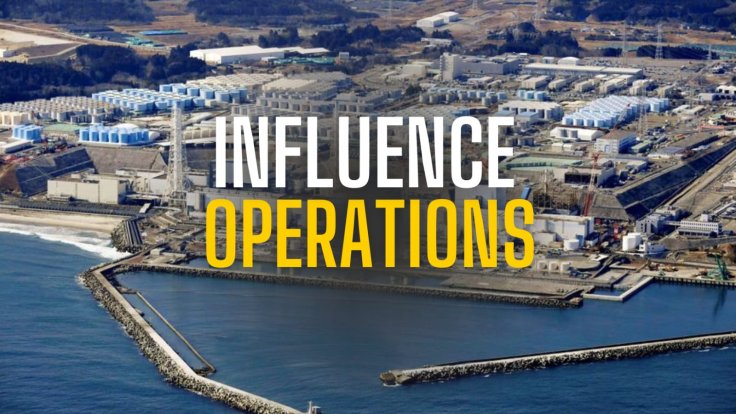
A growing wave of influence and disinformation
In recent months, Japan has been facing a surge of influence and disinformation campaigns originating from China, especially concerning the Fukushima water release issue. This uptick appears to have been triggered by the announcement of the end of the International Atomic Energy Agency's (IAEA) assessments and their recommendation in favor of discharging the treated water in the decommissioned Fukushima plant. This article aims to shed light on China's approach to achieving its objectives in the information sphere, focusing on its efforts to control public opinion, conduct psychological warfare, and employ legal warfare against Japan. Analysis of the recent activity sheds light on the ecosystem of Chinese operations, as well as their modus operandi in shaping public opinion.
Chinese Political Influence - Coordinated efforts to achieve strategic goals
China's influence operations against Japan serve four main goals:
- Projecting influence abroad by controlling the discourse.
- Managing Chinese diasporas and utilizing them as influencers.
- Establishing strong ties with foreign entities or actors.
- Forming a China-centred strategic alliance in opposition to Western alliances.
In order to achieve the above-mentioned goals, China's engages in information and influence wars against its adversaries. Chinese influence efforts are based on a coordinated set of activities, focusing on 3 main fields. This approach creates a synchronized, synergistic effort that manages to control the desired narrative and advance China's strategic goals.
1. Controlling Public Opinion: Comprised of both internally and externally-focused activities, this involves shaping a unified discourse supported by the Chinese population and China-led actors while countering the narratives of its enemies.
2. Psychological Warfare: China floods the information space with narratives designed to instill fear and uncertainty, repeating them over and over.
3. Legal Warfare: If necessary, China employs legal means, including economic sanctions and bans, to influence the behaviour of its targets.
To mount its influence campaigns and achieve its objectives, China has created a comprehensive eco-system comprised of an extensive combination of both Chinese-attributed and non-attributed actors and assets. The goal of this eco-system is to spread, share and amplify the desired narratives. Analysis of past and present Chinese influence activities has identified five main groups of actors and assets working in concert:
1. Politics & Diplomacy: Chinese ministries, political figures, and ambassadors play a vital role in propagating official statements and narratives.
2. Media: Mainstream media outlets and social media networks are utilized to spread information and influence public opinion.
3. Influencers & Researchers: Individuals, experts, think tanks and research centers contribute to amplifying China's narratives.
4. Chinese Communities: The local population and Chinese diasporas are mobilized to advance China's interests.
5. Inauthentic Actors: These include sock puppets, fake accounts, and bots that amplify and manipulate narratives.
The actors and assets comprising this ecosystem complement each other and have a fairly well-defined role aimed at accomplishing the objectives of the influence operation preserving China's interests in the information war.
Fukushima Water Release - Anatomy of an Influence Battle
China has been disseminating a range of narratives against Japan in relation to the Fukushima water release, with the main themes falling under environmental discourse, anti-nuclear discourse, and conspiracy theories.
In the environmental arena, the narratives center around accusations that the water release is detrimental to the environment in general, specifically the Pacific Ocean and the marine species inhabiting it. The narrative further asserts that the water release will negatively impact small businesses in the region and their reputation.
Anti-nuclear discourse is supported by narratives that the water release is causing diseases and posing a threat to mankind. It also alleges that Japan may use the Fukushima incident as a basis for future nuclear activities.
Finally, Chinese-led actors are actively promoting conspiracy theories. These theories claim that TEPCO and Japanese authorities have lied about Fukushima-related data. They include allegations of insufficient information, lack of access to reliable data, and stress the weakness of the information that is available.
When looking at a Chinese influence operation in its entirety, certain recurring patterns can be identified. A simplified example will typically include most or all of the following steps:
- A Chinese official issues a statement or call to action.
- Chinese media outlets publish and disseminate the information.
- Influencers, researchers, activists, and commentators react to the news and share their views.
- Pro-Chinese individuals and platforms promote the narratives, customizing them to the target audience.
- Attributed and non-attributed actors amplify the phenomenon using inauthentic techniques, such as mass sharing and buying likes.
In the case of the Fukushima influence campaign for example, Chinese diplomats and political figures play a central role. For instance, during a press conference, Foreign Ministry Spokesperson Wang Wenbin criticized Japan's special fund to subsidize the Fukushima fishing industry, asserting that it was compensation to silence public discontent towards the water release plan.
In tandem, the Twitter account of the spokesperson also posted about the reaction: "Japan's special fund to compensate Fukushima's fishing industry simply tells people that there is indeed something wrong about the ocean discharge."
Chinese media outlets such as Global Times and CGTN then proceeded to publish this statement immediately with catchy titles such as "China says Japanese govt's fund subsidizing local fishing industry 'hush money'", while influencers and organizations further propagated it on social media.
Finally, inauthentic actors, including pro-Russian accounts and potentially automated bots, amplified the narrative to create a broader impact - posting memes, articles, videos, etc.
In summary, China's influence operations targeting Japan employ a multifaceted approach involving the control of public opinion, psychological warfare, and legal means to shape narratives in its favor. The Fukushima water release activity exemplifies how Chinese operations employ various actors and media platforms to amplify their narratives effectively. As such operations continue to evolve, it is crucial for Japan and other nations to remain vigilant in countering disinformation and maintaining an accurate understanding of events.
DISCLAIMER: IBT does not endorse the above content.









